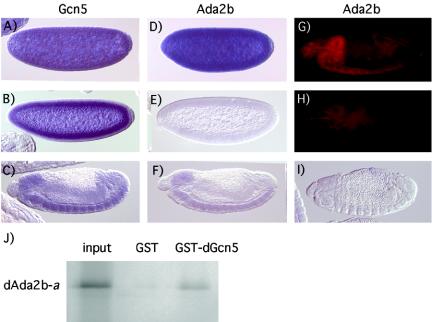FIG. 2.
Drosophila Ada2b and Gcn5 interact and are expressed in similar patterns during embryogenesis. (A to I) Lateral views of embryos hybridized with digoxigenin-labeled RNA probes or with a dAda2b antibody. Anterior is to the left and dorsal is up. (A to C) Hybridization of a dGcn5 probe to wild-type embryos. Precellular (A), cellularized (B), and advanced-stage embryos (C) are shown. In early embryos the message is ubiquitously distributed due to its maternal contribution. In late-stage embryos, expression is strongest in the CNS, but is also present in the gut. (D to F) Wild-type embryos incubated with a dAda2b probe. Ubiquitous staining is observed in precellular embryos (D). Maternal dAda2b mRNA is absent from cellularized embryos (E). In advanced-stage embryos, expression is strongest in the CNS, but low levels of message are also found in the gut (F). (G and H) Stage 16 embryos stained with a dAda2b antibody. In wild-type embryos (G), strong staining is observed in the CNS. Most of the dAda2b protein has disappeared by this stage of development in dAda2b mutant embryos (H). (I) In dAda2b mutant embryos, no zygotic dAda2b mRNA can be detected. (J) Interaction between dAda2b and dGcn5 proteins in vitro. The dAda2b isoform a cDNA was in vitro translated and incubated with GST (control) or a GST-dGcn5 fusion protein. Ten percent of the input was run on a gel together with eluates of GST and GST-dGcn5 resins. The dAda2b-a protein is efficiently retained by GST-dGcn5.

